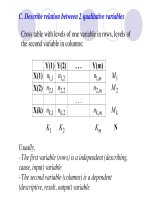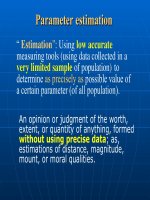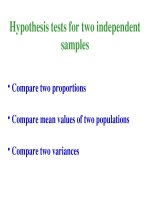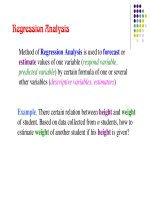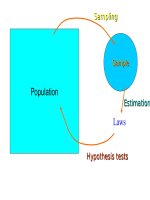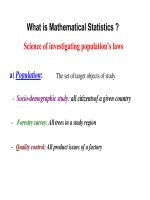Lý Thuyết: Parts Of Speech Từ Loại ( Bản Tiếng Anh)
Bạn đang xem bản rút gọn của tài liệu. Xem và tải ngay bản đầy đủ của tài liệu tại đây (54.72 KB, 4 trang )
Parts of Speech
Learning about the parts of speech is the first step in grammar study just as learning the letters of
the alphabet is the first step to being able to read and write. From learning the parts of speech
we begin to understand the use or function of words and how words are joined together to
make meaningful communication. To understand what a part of speech is, you must understand
the idea of putting similar things together into groups or categories.
1. Nouns
A noun is often defined as a word which names a person, place or thing. Here are some
examples of nouns: boy, river, friend, Mexico, triangle, day, school, truth, university, idea,
John F. Kennedy, movie, aunt, vacation, eye, dream, flag, teacher, class, grammar. John F.
Kennedy is a noun because it is the name of a person; Mexico is a noun because it is the name of
a place; and boy is a noun because it is the name of a thing.
2. Verbs
A verb is often defined as a word which shows action or state of being. The verb is the heart of a
sentence - every sentence must have a verb. Recognizing the verb is often the most important
step in understanding the meaning of a sentence. In the sentence The dog bit the man, bit is the
verb and the word which shows the action of the sentence. In the sentence The man is sitting on
a chair, even though the action doesn't show much activity, sitting is the verb of the sentence. In
the sentence She is a smart girl, there is no action but a state of being expressed by the verb is.
The word be is different from other verbs in many ways but can still be thought of as a verb.
3. Adjectives
An adjective is often defined as a word which describes or gives more information about a noun or
pronoun. Adjectives describe nouns in terms of such qualities as size, color, number, and kind. In
the sentence The lazy dog sat on the rug, the word lazy is an adjective which gives more
information about the noun dog. We can add more adjectives to describe the dog as well as in the
sentence The lazy, old, brown dog sat on the rug. We can also add adjectives to describe the
rug as in the sentence The lazy, old, brown dog sat on the beautiful, expensive, new rug. The
adjectives do not change the basic meaning or structure of the sentence, but they do give a lot
more information about the dog and the rug. As you can see in the example above, when more
than one adjective is used, a comma (,) is used between the adjectives.
Usually an adjective comes before the noun that it describes, as in tall man. It can also come after
a form of the word be as in The man is tall. More than one adjective can be used in this
position in the sentence The man is tall, dark and handsome. In later lessons, you will learn how
to make comparisons with adjectives.
1
4. Adverbs
We have seen that an adjective is a word that gives more information about a noun or
pronoun. An adverb is usually defined as a word that gives more information about a verb, an
adjective or another adverb. Adverbs describe verbs, adjectives and adverbs in terms of such
qualities as time, frequency and manner. In the sentence Sue runs fast, fast describes how or
the manner in which Sue runs. In the sentence Sue runs very fast, very describes the adverb
fast and gives information about how fast Sue runs.
Most, but not all adverbs end in -ly as in But not all words that end in -ly are adverbs (ugly is an
adjective, supply and reply can both be nouns or verbs). Many times an adjective can be made into
an adverb by adding -ly as in nicely, quickly, completely, sincerely.
5. Pronouns
A pronoun is often defined as a word which can be used instead of a noun. For example, instead
of saying John is a student, the pronoun he can be used in place of the noun John and the
sentence becomes He is a student. We use pronouns very often, especially so that we do not
have to keep on repeating a noun. There are several types of pronouns.
a. Personal pronouns
Subjective pronouns
Objective pronouns
Reflexive pronouns
Reciprocal pronouns
b. Possessive pronouns
c. Demonstrative pronouns
d. Indefinite pronouns
e. Relative pronouns
f.
Interrogative pronouns
6. Prepositions
A preposition is a word which shows relationships among other words in the sentence. The
relationships include direction, place, time, cause, manner and amount. In the sentence She went
to the store, to is a preposition which shows direction. In the sentence He came by bus, by is
a preposition which shows manner. In the sentence They will be here at three o'clock, at is a
preposition which shows time and in the sentence It is under the table, under is a preposition which
shows place.
A preposition always goes with a noun or pronoun which is called the object of the
preposition. The preposition is almost always before the noun or pronoun and that is why it is
called a preposition. The preposition and the object of the preposition together are called a
prepositional phrase.
2
7. Conjunctions
A conjunction is a word that connects other words or groups of words. In the sentence Bob and
Dan are friends the conjunction and connects two nouns and in the sentence He will drive or
fly, the conjunction or connects two verbs. In the sentence It is early but we can go, the
conjunction but connects two groups of words.
Coordinating conjunctions are conjunctions which connect two equal parts of a sentence. The
most common ones are and, or, but, and so which are used in the following ways:
and is used to join or add words together in the sentence They ate and drank.
or is used to show choice or possibilities as in the sentence He will be here on Monday or
Tuesday.
but is used to show opposite or conflicting ideas as in the sentence She is small but strong.
so is used to show result as in the sentence I was tired so I went to sleep.
Subordinating conjunctions connect two parts of a sentence that are not equal and will be
discussed more in another class. For now, you should know some of the more common
subordinating conjunctions such as:
after
before
unless
although
if
until
as
since
when
because
than
while
Correlative conjunctions are pairs of conjunctions that work together. In the sentence Both Jan
and Meg are good swimmers, both . . .and are correlative conjunctions. The most common
correlative conjunctions are:
both . . .and
either . . . or
neither . . . nor
not only . . . but also
8. Interjections
An interjection is an unusual kind of word, because it often stands alone. Interjections are words
which express emotion or surprise, and they are usually followed by exclamation marks. Examples:
Ouch!, Hello!, Hurray!, Oh no!, Ha!
9. Determiners
Determiners are words that are used with nouns to clarify the noun. They can clarify:
to define something or someone
to state the amount of people, things or other nouns
to state possessives
to state something or someone is specific
to state how things or people are distributed
3
to state the difference between nouns
to state someone or something is not specific
There are different types of determiners. There type of determiner depends on the type of noun.
Singular nouns always need a determiner. Plural nouns the determiner is optional. Uncountable
nouns the determiner is also optional.
There are about 50 different determiners in the English language they include:
Articles: a, an, the
Demonstratives: this, that, these, those, which etc.
Possessives: my, your, our, their, his, hers, whose, my friend's, our friends', etc.
Quantifiers: few, a few, many, much, each, every, some, any etc.
Numbers: one, two, three, twenty, forty
Ordinals: first, second, 1st 2nd, 3rd, last, next, etc.
10. Auxiliary verbs
Auxiliary verbs (or helping verbs) such as will, shall, may, might, can, could, must, ought to, should,
would, used to, need are used in conjunction with main verbs to express shades of time and mood.
The combination of helping verbs with main verbs creates what are called verb phrases or verb
strings. In the following sentence, "will have been" are helping or auxiliary verbs and "studying" is
the main verb; the whole verb string is underlined:
As of next August, I will have been studying chemistry for ten years.
a. Primary Auxiliaries
have, do and be combine with main verbs to indicate time and voice. As auxiliaries, the verbs be,
have and do can change form to indicate changes in subject and time.
He had won the election.
They did write that novel together.
I am going now.
He was winning the election.
They have been writing that novel for a long time.
b. Modal Auxiliaries
Other helping verbs, called modal auxiliaries or modals, such as can, could, may, might, must,
ought to, shall, should, will, and would, do not change form for different subjects.
Modal Auxiliaries, can have various meanings such as necessity, advice, ability, expectation,
permission, possibility, etc.,
4


